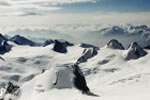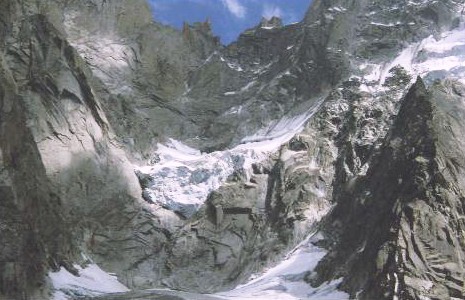


 |
 |
 |
In highland areas the most obvious glaciers features are usually those created by erosion, not deposition. Features such as corries, ribbon lakes, U shaped valleys and hanging valleys are typical of upland areas such as the Alps in Europe, the English Lake District and the Southern Alps in New Zealand.
Corries
A corrie (also called a cirque or cwm) starts as a snow patch on a cold mountain side. The temperatures must be low enough to allow the snow to remain all year round. Under these conditions snow can accumulate and the snow patch will grow in size and depth each year. Due to temperature changes and pressure, the snow becomes altered to ice, and when sufficient ice has accumulated it will begin to move downhill under the influence of gravity. For information on how snow is altered to ice, read The origins of Glaciers.

In the large snow patch, or a niche
glacier, erosion occurs above and below the surface of the ice.
Above the surface freeze-thaw will be an important process. It weakens and dislodges
rock material from the corrie walls, helping to steepen them and cut them backwards
into the mountain side. In an area such as the European Alps, the summer temperatures
may vary widely between day and night, making freeze thaw a daily process. During
the winter however, there may be almost no melting of ice for months, and freeze-thaw
will cease to operate.
Freeze thaw beneath the ice surface aids in the disintegration of the underlying
rocks; a process called nivation.
Below the ice there is a scouring action produced by the rotational movement of the ice as it moves down hill, and abrasion from the rock debris held in the ice. The rocks embedded in the ice scrape away at the underlying surface, slowly producing a curved hollow. Most of the erosion occurs in the centre of the ice, with less at the back, sides and front.
This causes a deepening of the hollow in which the snow has accumulated, a steepening of the walls behind and to its sides, and an 'armchair' shaped features is gradually produced.

The true shape of the corrie isn't
visible whilst it contains a glacier, but in areas where glaciation is no longer
active, we can see how the base has become hollowed out by the rotational movement
of the ice. It is also possible to see the corrie lip - a raised area at the
front of the corrie where the ice used to spill out and start its journey down
the mountain.
To understand why there is a lip you need to think about the rotational movement
of ice, where erosion will be most effective, and where it will be least effective...
Erosion is most effective in the centre of the corrie, but as the ice rotates forwards and upwards its erosional power is greatly reduced. This means that erosion at the front edge of the corrie is less than in the middle, so there is a deep corrie centre and a raised lip at the edge.
Along the glacier base and sides plucking, the process whereby rocks become frozen to the slowly moving ice and literally plucked from their location, may occur. This is common in warm glaciers that occasionally become locally frozen to their bed due to water freezing when pressure is reduced. Whilst the rest of the glacier continues to move, the frozen section experiences an increasing pull from the surrounding ice. This eventually wrenches the frozen patch of ice away from the bedrock, pulling attached rocks with it.
In areas where glaciation is not occurring now, corries are important evidence of past glacial activity. They appear as armchair shaped gouges out of mountain sides, frequently with a small lake, or tarn, occupying the scooped out base of the corrie. Red Tarn on Helvellyn (English Lake District) is a classic example.

We value
your ideas and suggestions. Please contact the
maintainer of this site.
This page
can be found at: http://www.geography-site.co.uk
Last update to
this statement was on:
February 23, 2006
© Copyright Geography Site